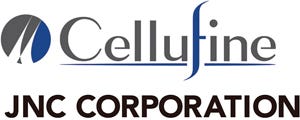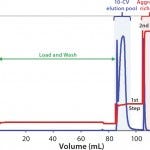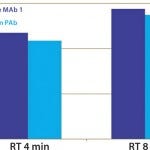- Sponsored Content
Removal of Antibody Aggregates Using Cellufine MAX GSRemoval of Antibody Aggregates Using Cellufine MAX GS
August 15, 2014
 Purification of therapeutic monoclonal antibodies (MAbs) requires advanced and selective means for separating aggregates from target monomers. Cellufine MAX GS chromatography media are optimized for higher capacity, better separation, and greater selectivity to improve downstream purification of MAbs. JNC Corporation’s new strong cation exchanger, Cellufine MAX GS, has optimized ligand density for improved dynamic binding capacity and selectivity and superior pressure flow characteristics, which are required by MAb purification platforms.
Purification of therapeutic monoclonal antibodies (MAbs) requires advanced and selective means for separating aggregates from target monomers. Cellufine MAX GS chromatography media are optimized for higher capacity, better separation, and greater selectivity to improve downstream purification of MAbs. JNC Corporation’s new strong cation exchanger, Cellufine MAX GS, has optimized ligand density for improved dynamic binding capacity and selectivity and superior pressure flow characteristics, which are required by MAb purification platforms.

FIGURE 1: Separation of aggregates by stepwise elution.
MAb load = 75 mg/mL resin; column = 5 mm ID 5 cm L, A buffer = 10 mM Na-Acetate pH 4.5 + 50 mM NaCl; B buffer = 10 mM Na-Acetate pH 4.5 + 1 M NaCl; load and wash = 0 % B, first step = 18.5 % B, second step = 100 % B; flow = 0.17 mL/min (load), 0.50 mL/min (elution); sample = HCl treated mouse MAb1 (monomer: 92.6%, dimer = 4.5%, aggregates = 2.9%.
MAb Monomer/Aggregates Separation: Cellufine MAX GS exhibits exceptional selectivity between MAb monomers and their aggregates.
Figure 1 and Table 1show monomer and aggregates separation of purified mouse IgG subclass 1 from mouse ascites (MAb1) under NaCl stepwise elution. MAb1 was treated with 1 M HCl (pH 2.5, 30 min) to generate aggregates. This solution (with a composition as described in Table 1) was used for high-loading studies (75 mg monomer/mL resin). Cellufine MAX GS achieved excellent separation and recovery as confirmed by size-exclusion chromatography.

TABLE 1: MAb1 recovery and reduction of the dimer and aggregates; recovery was 93.5%, and purity was 99.3% (in 10 CV elution pool).
Dynamic Binding Capacities: Efficient mass-transfer characteristics of Cellufine MAX GS translate to superior dynamic binding capacities (DBCs).
Figure 2 displays DBC for MAb1 and hPAb (human polyclonal antibody), which offer performance advantages in both capture and polishing steps. Cellufine MAX GS can be operated suitably at residence times of 48 minutes in antibody purification.

FIGURE 2: DBC of Cellufine MAX GS for antibodies.
Column = 5 mm ID 5 cm L, loading buffer; Mouse MAb1 = 10 mM Na-Acetate pH 4.5 + 50 mM NaCl; Human PAb = 10 mM Na-Acetate pH 5.0 + 50 mM NaCl.
Other Characteristics of Cellufine MAX GS: Cellulose is a well-known natural product with high chemical and physical stability. Cellufine MAX uses a highly cross-linked cellulose as the base bead, so Cellufine MAX GS is operable at high flow rates. All Cellufine ion-exchange (IEX) media can be cleaned and regenerated with 0.5 M NaOH solutions. Cellufine MAX GS is suitable for downstream MAb purification platforms. For more information on Cellufine MAX GS and other Cellufine products, please consult the JNC Corporation Cellufine website.
Shigeyuki Aoyama is a manager in the Life Chemicals Launch Office of JNC Corporation, 2-2-1 Otemachi, Chiyoda-ku, Tokyo, 100-8105, Japan;
[email protected]; www.jnc-corp.co.jp/fine/en/cellufine
You May Also Like






